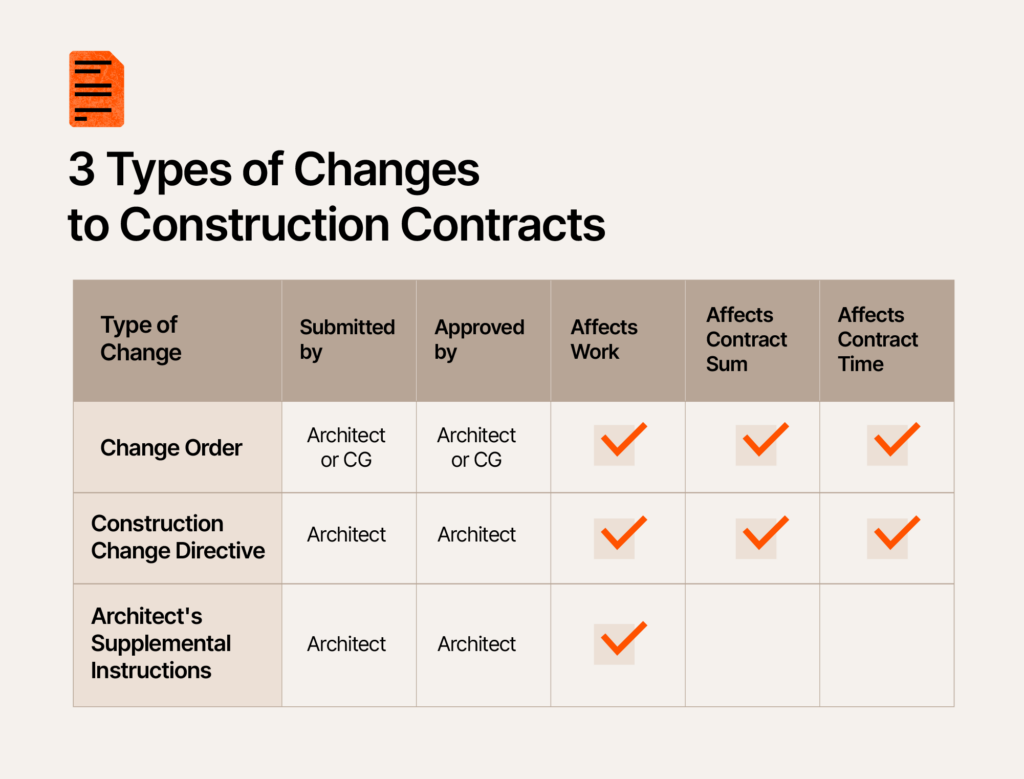— 4 min read
How to Understand and Use Architect’s Supplemental Instructions
Last Updated Apr 23, 2025
Last Updated Apr 23, 2025

Architect’s supplemental instructions, also known as ASI, offer a means of making small changes to the construction contract after it’s signed. The ASI is a document issued by the architect on a project to communicate additions, changes or explanations to the original construction documents. This article will discuss best practices for following the architect's supplemental instructions and their implications for a construction project.
Table of contents
ASI vs. Changes Orders & Directives
The architect’s supplemental instructions is a formal document that the project architect issues to formalize changes to previous construction documents. The content of the ASI could direct any sort of changes or clarifications by elaborating on original instructions or changing small details, as long as those changes don’t result in altered costs or timelines.
The ASI is only one of the ways to make changes to construction documents once a project is underway – the other two are change orders and change directives. Construction change orders are used to make alterations to the project scope that result in a change to the project cost or completion date.
Contractors issue a change order request to come to a new agreement to ensure that the project documents reflect these changes.
Construction change directives are required changes that the owner or architect issues that the contractor must comply with. They’re often used when the owner and the contractor can’t agree to project changes.
The key difference between ASIs and construction change orders and change directives is that the ASI can’t be used to make changes that would impact the project timeline or schedule. That means that their main purpose is for tweaks and clarifications. If an ASI results in extra labor or materials that will increase costs, it may lead to a change order.

Why would an architect issue supplemental instructions?
The ASI serves a smaller role in clarifying or changing instructions on items that won’t impact the original construction agreement.
Some of the main reasons for issuing an ASI are:
- To fix a mistake or a missing piece of information, like specifying material finishes
- Adjusting minor design elements
- To respond to an RFI with additional information or clarifications
- A change in project conditions or a response to unforeseen conditions
- Somebody has asked for a change to material, color or layout
The Benefits of Using ASIs
ASIs provide a number of benefits that help architects and contractors complete their work seamlessly and according to project requirements.
Boosts Speed
The main benefit to using ASIs over change orders is expediency. ASIs skip over all the approval steps that change orders must undergo. When architects need to add information not included in original construction documents, they simply issue ASIs.
Improves Communication
ASIs are a method of providing more information between the design team and project contractors, allowing them to have fuller understanding of their needs and project requirements and improving communication.
Reduces Rework
By clarifying details early on, ASIs can prevent misunderstandings, errors and resulting costly rework, meaning improved efficiency and cost savings.
Maintains Design Intent
By providing an opportunity for further details, the ASI allows architects to make their design intent clear, so they can fulfill their duties of interpreting the contract requirements under the owner/architect agreement.
How Architect's Supplemental Instructions Work During Projects
The Architect’s Supplemental Instruction can be completed using AIA form G710. AIA documents are largely considered industry standard. The architect fills out the form and forwards it to the general contractor.
Once ASIs are issued, they become part of the collection of construction documents and are legally enforceable. The first step the contractor needs to take is to confirm that the portion of work impacted by the ASI hasn’t started yet. If it has, and work needs to be undone or redone, the ASI has to be rescinded so a change order can be issued in its place.
Implications of ASI on Pay Applications
ASIs generally don’t change the amount the contractor will be paid, since they do not impact project costs and timeline. However, the contractor should keep the ASI as part of the construction documents, and make sure pay applications reflect the changes made in the ASI.
For instance, if the ASI changed the paint color in the lobby from taupe to ecru, the contractor should be careful to bill for the costs associated with buying and painting ecru paint. If the bill says anything about taupe paint, payment can be delayed even if the proper paint color has been installed.
Build a Strong Foundation with our Preconstruction Course
With 20+ years of experience, Ben Ashburn teaches you how to streamline planning, bidding, and procurement for better outcomes.

Managing ASIs for Better Project Performance
Architect's supplemental instructions are an important document for maintaining clarity and efficiency in construction projects. When contractors receive ASIs, they need to understand their contents, act quickly to ensure the work referred to in the ASI hasn’t already been completed yet and maintain the ASI as an addition to the contract documents.
When used effectively as a tool to modify construction documents, ASIs can facilitate clear communication between project stakeholders and ensure precise documentation, both of which can prevent costly mistakes and ensure that projects adhere to their intended design.
Was this article helpful?
Thank you for your submission.
0%
0%
You voted that this article was . Was this a mistake? If so, change your vote here.
Scroll less, learn more about construction.
Subscribe to The Blueprint, Procore’s construction newsletter, to get content from industry experts delivered straight to your inbox.
By clicking this button, you agree to our Privacy Notice and Terms of Service.
Categories:
Tags:
Written by
Kristen Frisa
70 articles
Kristen Frisa is a contributing writer for Procore. She also contributes to a variety of industry publications as a freelance writer focused on finance and construction technology. Kristen holds a Bachelor of Arts in Philosophy and History from Western University, with a post-graduate certificate in journalism from Sheridan College. She lives in Ontario, Canada.
View profileExplore more helpful resources
Improving Project Monitoring with Construction Quantity Tracking
Once a construction project is underway, builders need to closely monitor the project’s progress and make sure it’s staying on schedule and within budget. Quantity tracking helps construction leaders manage...

Streamlining Construction Projects with Effective BIM Coordination
The old saying goes: if you fail to plan, you plan to fail. Construction professionals know this better than nearly anyone. To take a project from a vision in an owner’s...

Construction Invoice Factoring: A Quick Guide
Construction companies need to maintain consistent cash flow. Projects can take years to complete, and delays and unforeseen events may keep expenses mounting. Adding to this load are typically high upfront...

Understanding Subcontractor Bid Packages in Construction
Construction bid packages can have a cascading impact on the success of a construction project. The quality of a bid project may affect the quality of the bids, which in...